Effortless Firewood Splitting: Simple Trick Revealed
- February 21, 2024
- 0 comment
Immersed in the tradition of using wood to heat my home, I’ve developed a complex relationship with the act of splitting firewood. On one hand, the unparalleled warmth and cozy ambiance it brings to my living space is something I deeply value.

On the other, the demanding labor involved in preparing the firewood, coupled with the cumbersome chore of organizing the wood and maintaining the tools, can be quite overwhelming. It’s a task that, until recently, I approached with a mix of anticipation and reluctance.
However, a serendipitous discovery has dramatically altered my perspective and method of splitting wood. I’ve come across a remarkably simple yet effective technique that has transformed this once daunting task into an unexpectedly efficient and manageable part of my routine. This newfound approach has not only made the process more tolerable but has significantly enhanced my efficiency and enjoyment of the entire wood-splitting experience.
Table of Content List:
The Genesis of the Trick
The frustration of chasing wedges and logs that scatter off the chopping block is a common grievance for anyone who splits their firewood. It’s a time-consuming nuisance that disrupts the rhythm of work and, frankly, tests patience. The solution I discovered, and am excited to share, is remarkably simple and requires just two items: a modest length of chain and a high-quality rubber bungee cord.
1. Materials Needed
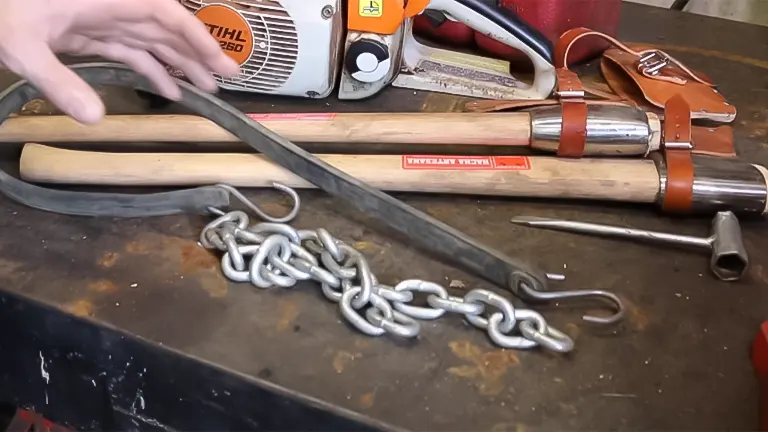
- Chain: A piece about 12 to 16 inches in length suffices. The weight or thickness isn’t critical, but durability is. I used a heavy chain I had on hand, but anything sturdy enough to withstand the force of splitting wood works.
- Rubber Bungee: Opt for a heavy-duty, high-quality rubber bungee. The cheap variants tend to crack and dry out after a season’s use, but a good, preferably American-made, bungee can last years.
2. The Build Process
Creating the “Splitnader” is straightforward. It involves manipulating one end of a chain to form a loop, a task that can be accomplished with either a vise or a hammer.
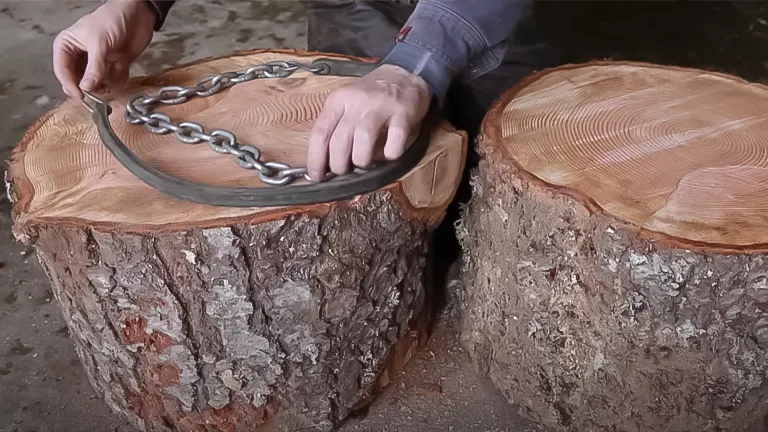
This loop, when used together with a rubber bungee cord, introduces a level of adjustability to the setup. This means it can be modified to fit logs of varying diameters, providing a versatile solution for handling different sizes of firewood efficiently.
3. Implementing the Trick
Once the chain is looped and fastened with the bungee, the next step is to encircle the lower section of the log you’re preparing to split with this arrangement.
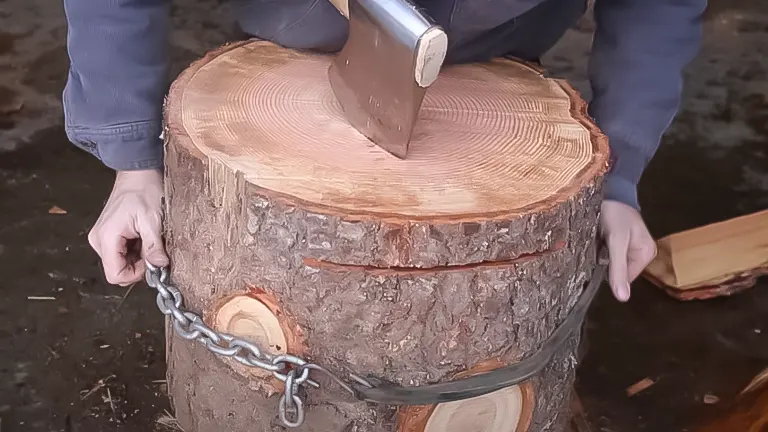
By placing it just below the midpoint of the log, you significantly reduce the chance of accidentally hitting the chain or bungee with your axe.
This technique holds the split pieces of the log together, eliminating the need to collect scattered pieces post-splitting, thereby streamlining the entire wood-splitting process.
4. A Lesson Learned
My initial trials involved using a bungee cord that was too lengthy, which ended up being counterproductive.
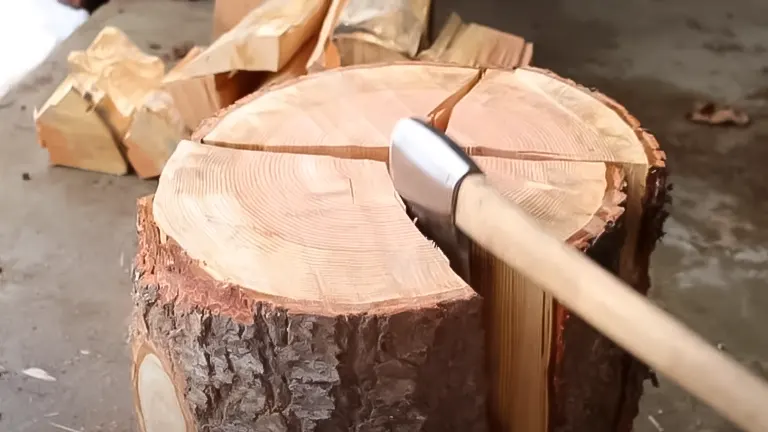
The essential takeaway here is the importance of ensuring the chain sufficiently encircles the bulk of the log, complemented by a shorter bungee for a secure fit.
Making this adjustment had a notable impact on the process’s efficiency, primarily by minimizing the likelihood of severing the bungee during splitting.
5. The Outcome
The introduction of the Splitnader into my firewood preparation routine has been transformative. What used to be a task marred by frequent annoyances has evolved into a smooth, efficient operation.

I can now split wood more easily and maintain an organized workspace, thanks to the effectiveness of this simple solution. This innovation has fundamentally altered my approach to splitting firewood for the better.
Looking Forward
In my ongoing quest to optimize the wood-splitting process, I’ve also turned my attention to the tools I use. I am currently exploring the possibility of a specially designed axe that promises to elevate the efficiency and enjoyment of splitting wood even further. This potential future development signals my commitment to not just improving my technique but also ensuring the quality of the tools at my disposal.
Additional Information Tips
Here are four pieces of additional information that shed more light on the “Effortless Firewood Splitting: A Simple Trick Revealed” technique:
- Customization and Flexibility: The method allows for significant customization to suit individual preferences and requirements. Users can adjust the length of the chain and bungee to accommodate different log sizes, ensuring that the Splitnader can be used effectively across a wide range of wood types and diameters. This flexibility makes it an attractive option for those who deal with a variety of firewood.
- Durability and Longevity: Emphasis on choosing high-quality materials for the Splitnader, such as durable chains and robust rubber bungees, ensures that the tool can withstand the rigors of wood splitting over time. This focus on durability not only enhances the tool’s longevity but also ensures consistent performance, providing users with a reliable aid in their wood-splitting tasks.
- Safety Considerations: By keeping the split wood pieces contained, the Splitnader method indirectly enhances safety during the wood-splitting process. It reduces the likelihood of wood pieces flying off in unpredictable directions, which could potentially cause injury. Moreover, it minimizes the need to repeatedly bend down to pick up split wood, reducing back strain and the risk of related injuries.
- Environmental Impact: This wood-splitting technique, by virtue of its simplicity and reliance on minimal and reusable materials, has a lower environmental footprint compared to more complex or power-dependent splitting methods. The use of manual tools like the Splitnader aligns with sustainable practices by reducing reliance on fossil fuels and lowering noise pollution, making it an eco-friendly choice for environmentally conscious users.
These additional details highlight the practical benefits, safety enhancements, and environmental considerations associated with the “Effortless Firewood Splitting: A Simple Trick Revealed,” offering users a comprehensive understanding of its value and applicability.
Critical Factors Influencing User Choices
The effectiveness of the “Effortless Firewood Splitting: A Simple Trick Revealed” method hinges on several critical factors that influence user decisions. Firstly, the simplicity and accessibility of the required materials—a chain and a high-quality rubber bungee—are paramount, as these are readily available and affordable for most individuals.
Secondly, the versatility and adaptability of the technique to various log sizes and wood types play a significant role in its appeal, offering a broad application range for users with different needs. Additionally, the potential for increased safety and efficiency, by minimizing the risk of scattered wood pieces and reducing the physical strain of gathering split logs, significantly impacts user satisfaction. These factors, combined with the method’s innovative approach to a traditionally labor-intensive task, make it a compelling option for anyone looking to streamline their firewood splitting process.
Final Conclusion
For those engaged in the task of splitting firewood, whether by necessity or as a personal choice, the introduction of the Splitnader into your routine is something I strongly advocate for. This innovative technique exemplifies how minor modifications to traditional methods can significantly ease a laborious task, making it seamless and much less cumbersome.
By incorporating the Splitnader, along with utilizing quality tools tailored for the job, you may discover a newfound pleasure in what was once a daunting chore. This approach not only streamlines the process but also enhances the overall experience, potentially transforming your perspective on splitting firewood entirely.
Frequently Asked Questions
- What is the Splitnader, and how does it work?
The Splitnader is a homemade tool designed to simplify the process of splitting firewood. It utilizes a chain and a rubber bungee cord to create a loop that wraps around a log. This setup holds the log pieces together after splitting, reducing the effort needed to gather scattered pieces. - What materials do I need to create the Splitnader?
To create the Splitnader, you will need a length of chain (about 12 to 16 inches) and a high-quality rubber bungee cord. These materials are easily adjustable to accommodate logs of various sizes. - Can I make the Splitnader without a vise or hammer?
While a vise or hammer is recommended for securely closing the chain loop, if you don’t have these tools, you can use any sturdy tool that can apply enough force to bend and close the chain link. - Is the Splitnader suitable for logs of all sizes?
Yes, the Splitnader is adjustable and can be used on logs of various diameters. The length of the chain and bungee can be modified to fit the size of the log you’re splitting. - How do I correctly position the Splitnader on a log?
Position the Splitnader around the lower half of the log, slightly below the center. This placement minimizes the risk of the axe hitting the chain or bungee and ensures the log remains contained after splitting. - What should I do if the bungee cord is too long or too short?
If the bungee cord is too long, it may not hold the log pieces tightly enough. If it’s too short, it might not wrap around larger logs. Adjust the length of the bungee cord based on the average size of the logs you split, ensuring a snug fit. - How can I prevent the axe from damaging the Splitnader?
Carefully aim your axe strikes to the center of the log, avoiding the area where the Splitnader is wrapped. Using a shorter bungee and positioning the chain lower on the log can also help minimize contact with the axe. - Can the Splitnader be used with any type of wood?
Yes, the Splitnader is versatile and can be used to split different types of wood, from softer woods like pine to harder varieties like oak, as long as the wood is properly positioned and secured. - How does the Splitnader improve the firewood splitting process?
The Splitnader simplifies the splitting process by keeping split wood pieces together, eliminating the need to chase down scattered pieces. This makes splitting more efficient and less physically taxing. - Where can I find the materials to make a Splitnader?
Materials for the Splitnader can be found at most hardware stores or home improvement centers. Look for the chain and rubber bungee cord in the tools or gardening sections, respectively.
We’re eager to hear your feedback! If you’ve tried the “Effortless Firewood Splitting: A Simple Trick Revealed” method, please share your experiences and thoughts in the comments section below. Your personal insights and observations are invaluable to others who are considering this technique. By sharing your story, you could assist fellow wood splitters in making well-informed decisions and improving their own firewood splitting process. Let’s help each other make wood splitting easier and more efficient!

Edward Smith
Forestry AuthorWoodworking is about more than crafting; it's a harmonious connection with nature, mastering tools, and preserving our environment. I'm here to share my knowledge and experiences with you, forging a future where we can embrace wood's beauty and utility while safeguarding our forests' health and diversity.



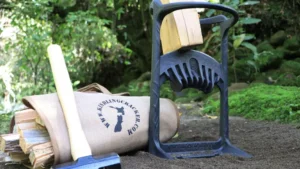


Leave your comment